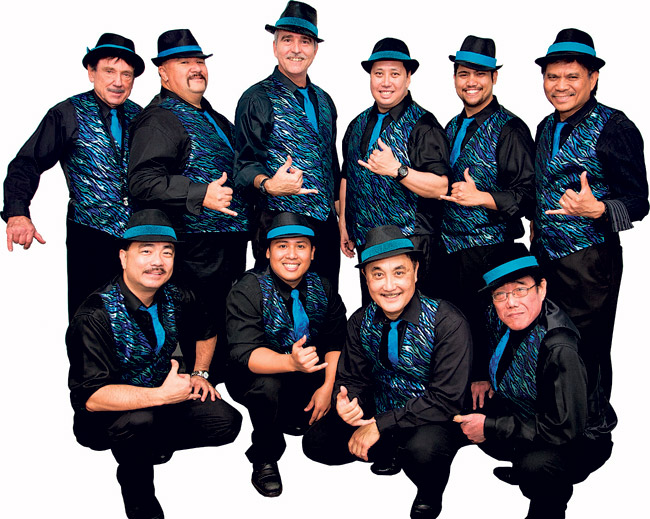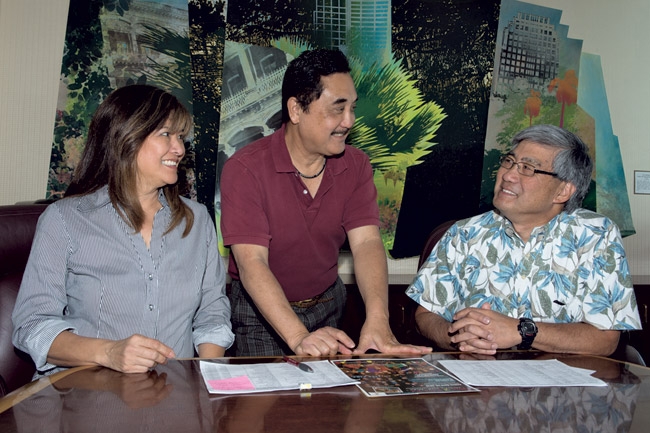A Late Classmate’s Living Legacy
The Hawaii Bone Marrow Donor Registry gala unites a recipient who beat cancer and the donor who made it possible
Online dating services have nothing over Hawaii Bone Marrow Donor Registry (HBMDR) when it comes to the art of making matches. One is in search of love, the other is in search of life.
nm_2
Each year, as many as 3,000 people in the United States die waiting for a bone marrow donor match. A significantly higher number of people die from complications arising from partially matched donors. Only 2 percent of Americans are on the national bone marrow donor registry, which makes finding a perfect donor match even more difficult. It isn’t simple to find a blood donor match, but bone marrow donors must be compatible on a deep genetic level – something that is especially hard to find for minorities, especially Asians and Native Hawaiians.
Right now, 180 Asians and 30 Hawaiian-Pacific Islanders are waiting for donors. They are in their final stages of life-threatening blood cell-related diseases, such as leukemia or lymphoma.
Hawaii’s most publicized case was leukemia patient Alana Dung, who in 1996 triggered a statewide and worldwide search for a bone marrow match. The 3-year-old received a transplant from a donor in Taiwan, but died after a courageous fight.
The plight of patients still rocks emotions and a sense of urgency in the complex and even controversial field of transplantations. Because human transplants are subject to voluntary donations, a range of health ethics issues can arise.
But when a family member or friend is faced with a life-threatening diagnosis, compassion can be the best medicine. HBMDR knows this and facilitates many “miracles with aloha.”
Sustaining the drive and awareness of this cause are 1972 Hilo High classmates Wes Fujimoto and Annie Yonashiro. Both now Honolulu residents in established careers as an attorney and hair salon operator, respectively, they have kept alive the dream of a fellow Hilo High classmate to match donors with recipients.
This year there is an ironic twist to their mission, as yet another classmate becomes involved in the quest for donors. More about that later.
For the sixth year, Fujimoto and Yonashiro co-chair the “Give 2 Live,” which raises awareness and funds for the local bone marrow registry. This year’s event is Friday, April 26, at 6 p.m. at Manoa Grand Ballroom. Featuring the R&B band Funkshun and 11 guest artists, the night will sparkle with the nostalgic music of the ’70s and ’80s. Guests also can shop for exciting merchandise and gifts at a calabash corner. Proceeds from tickets ($55-$75) support the work of tissue analysis and administering the intricate process of matching potential local donors with recipients needing bone marrow nationwide.
Annie’s husband, Roy Yonashiro, has served as the registry’s executive director for 16 years and previously was a volunteer. The Kaimuki High School graduate joined his wife and classmate Fujimoto when they became involved in the cause.
As Annie tells it, “In the late ’80s our classmate Patricia Ikeda Tamashiro from Hilo High School class of 1972 was diagnosed with leukemia. She was in need of a lifesaving bone marrow transplant. She did not find a match in the national registry and so her son, though not a perfect match, became her donor. Unfortunately, she did not survive.
“However, before she passed away, Tamashiro and others approached the state Legislature and lobbied for funding to start the Hawaii Bone Marrow Donor Registry in their mission to educate and recruit bone marrow donors for patients everywhere.”
Currently there are 80,000 registered donors in Hawaii, and more than 350 people who have donated bone marrow or blood stem cells, according to Roy.
Although transplants save thousands of lives each year, 70 percent of those needing marrow are unable to find a suitable donor. In a bone-marrow transplant, the patient’s diseased bone marrow is destroyed and healthy marrow is infused into the patient’s bloodstream.
Tissue screeners seek donors ages 18-44 who are in excellent health. The testing process is painless, and one remains on the registry until an exact match is made. Some donors have been matches for several patients.
Donating marrow is unlike donating a vital organ, such as a kidney, as bone marrow has the ability to regenerate itself.
One could say it’s a “full circle” cycle. That can be said, too, of the donor story that will be highlighted at Give 2 Live. Donors and recipients who consent to revealing their identities are united on stage for emotional and tearful meetings. The joyful embraces and testimonies that take place tell the story of life-giving triumphs more than any medical or scientific treatise could.
It should be quite an occasion when Karen Inouye Ochiai of Manoa, a pharmaceutical vaccine specialist, reunites with bone marrow recipient Allen Agor of Hawaii Kai. Three years ago, Agor, a public safety official with the U.S. Department of Homeland Security, was diagnosed with leukemia, but is alive and well today because of Ochiai.
The one-in-10 million chance of this rare match makes it a miracle of medical science. The fact that donor and recipient were found only eight miles apart on the same remote island is another remarkable development. It is record-setting in many respects.
But the serendipity doesn’t stop there.
Donor Ochiai is a Hilo High ’72 grad and classmate of HBMDR pioneer Tamashiro. Could there be a more fateful and noble network of classmates in the state?
Fujimoto, who was class president in 1972, shakes his head in disbelief but endorses the caring compassion shown by his fellow grads.
“Each year, we say this will be our last fundraiser, but inspiring stories like this bring us together again,” he says.
Sort of like a match made in heaven.
For tickets to the April 26 Give 2 Live benefit and information about HBMDR, email give2livemarrow@gmail.com.







